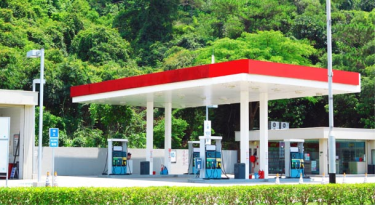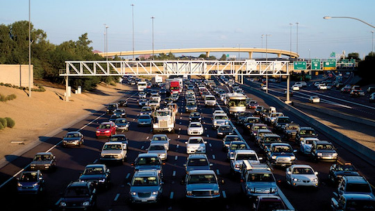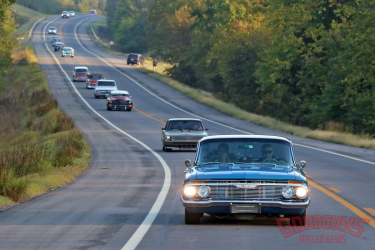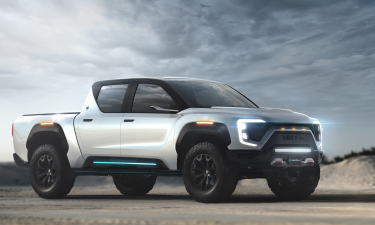

Welcome to Bumper to Bumper Radio!
Drive in anxious and cruise out confident with the best automotive information for your vehicle! Tune in to KTAR News 92.3 every Saturday from 11 a.m. to noon as Matt Allen helps listeners with their car problems. The show call in number is 602-277-5827.
Latest News From Bumper to Bumper Radio

As crude oil prices trend close to $30/bbl, Americans are seeing pump prices plummet across the country. On the week, gas price averages in 35 states decreased by double-digits, pushing the national average to $2.25, the cheapest price point of the year.
“The national gas price average is 13 cents cheaper on the week and nearly 20 cents less than the beginning of the month. These are significant decreases in just 7 and 16 days,” said Jeanette Casselano, AAA spokesperson. “AAA expects gas prices to continue trending cheaper, with the high likelihood of the national average hitting $2/gallon before the end of March.”
During this uncertain time of COVID-19, gas prices are declining despite increasing gasoline demand and decreasing U.S. stock levels.
Quick Stats
The nation’s top 10 largest weekly decreases are: Ohio (-27 cents), Kentucky (-21 cents), Michigan (-21 cents), Wisconsin (-21 cents), Indiana (-19 cents), Illinois (-19 cents), Oklahoma (-15 cents), Iowa (-15 cents), Maine (-15 cents) and Minnesota (-15 cents).
The nation’s top 10 least expensive markets are: Oklahoma ($1.92), Texas ($1.96), Mississippi ($1.96), South Carolina ($1.97), Ohio ($1.97), Indiana ($1.97), Missouri ($1.98), Kentucky ($1.99), Louisiana ($2.00) and Alabama ($2.00).
Great Lakes and Central States
Some of the largest weekly pump price savings in the country can be found in the Great Lakes and Central states. Eight out of the top 10 largest weekly decreases are states from the region: Ohio (-27 cents), Kentucky (-21 cents), Michigan (-21 cents), Wisconsin (-21 cents), Indiana (-19 cents), Illinois (-19 cents), Iowa (-15 cents) and Minnesota (-15 cents). All states in the region saw double-digit decreases, with South Dakota (-10 cents) seeing the smallest decrease on the week.
With the substantial drops at the pump, state gas prices in the region are relatively cheap, ranging from as low as $1.98 in Missouri to a high of $2.30 in Illinois.
With a draw of 1.8 million bbl, the Great Lakes and Central states region saw its first substantial drop in gasoline stocks in two months, according to the Energy Information Administration’s latest report. At 58 million bbl, stock levels remain healthy and in line with levels this time last year. If stocks were to decrease again in the coming week that would traditionally mean a pump price increase, but given current trends it’s more likely gas prices would decrease.

Drivers who live in cold and wet climates are all too familiar with what happens to roadways when the ice begins to thaw or flooding occurs. Potholes appear and they are a major pitfall of springtime driving. While hitting one can give you a jolt, it can also seriously damage your vehicle.
The non-profit Car Care Council urges motorists who have hit a pothole to watch out for the following warning signs that key safety-related systems may have been damaged:
Steering and suspension: Loss of control, including swaying when making routine turns, bottoming out on city streets or bouncing excessively on rough roads
Alignment: Pulling in one direction, instead of maintaining a straight path, and uneven tire wear
Tires: Low tire pressure, bulges, blisters on the sidewalls or dents in the wheel rim
“We recently surveyed drivers throughout the country and found that nearly all have hit a pothole at some point, but only one-third of those motorists had their vehicle checked after doing so,” said Rich White, executive director, Car Care Council. “Potholes can pack a powerful punch, adversely affecting a vehicle’s handling and performance. If you hit one, be sure to look for the warning signs of damage and have your vehicle inspected to ensure safe, dependable operation.”

- Boston (149 hours lost due to congestion, which equates to more than six days) ranked as the most congested city in the U.S. for the second consecutive year, followed by Chicago (145 hours), Philadelphia (142 hours), New York City (140 hours) and Washington D.C. (124 hours)
- Bogota, Columbia topped the list of most congested cities in the world, with drivers losing 191 hours a year
- Los Angeles holds the two worst corridors in the U.S., where drivers on the US-101 and I-5 waste 80 and 76 hours per year at peak hours in congestion, respectively
- Philadelphia, Washington D.C. and San Francisco have the three slowest last mile speeds of 10 MPH in the U.S., meaning it is faster to bike than drive or taking the bus
- Congestion delays have decreased in four of the five most congested cities in the U.S., led by Washington D.C.'s 11 percent reduction
KIRKLAND, Wash., March 9, 2020 -- INRIX, Inc., a world leader in transportation analytics and connected car services, today published the 2019 Global Traffic Scorecard that identified and ranked congestion and mobility trends in more than 900 cities, across 43 countries. The report found that on average, Americans lost 99 hours a year due to congestion, costing them nearly $88 billion in 2019, an average of $1,377 per year. From 2017 to 2019 the average time lost by American drivers has increased by two hours as economic and urban growth continue nationally.
In the U.S., the 2019 Global Traffic Scorecard analyzed congestion and the severity of it in the top 66 urban areas. For the second consecutive year, Boston ranked as the most congested city in the U.S. with the average commuter in the metro area losing 149 hours per year to congestion, costing $2,205 per driver in time lost. Chicago (145 hours, $2,059 lost), Philadelphia (142 hours, $2,016 lost), New York City (140 hours, $1,988 lost) and Washington D.C. (124 hours, $1,761 lost) rounded out the Top 5. While known historically for its congestion, Los Angeles' (ranked sixth in congestion; 103 hours lost in 2019) constant gridlock does not have the severity as the other top-ranked cities due to its sprawling geography and massive road network. On the other hand, Wichita, Kansas, for the second year in a row, had the lowest congestion levels in the U.S. with drivers losing less than two hours a year.
"Congestion costs Americans billions of dollars each year. However, it appears to be stabilizing in some of the country's most congested metros – with delays raising roughly three percent nationwide since 2017," said Trevor Reed, transportation analyst at INRIX. "The continued innovation and investment in smarter roadway management is showing early signs of progress. To reflect an increasingly diverse mobility landscape, the 2019 Global Traffic Scorecard includes both public transport and biking metrics for the first time."
The Most Congested Corridors in the U.S.
Los Angeles holds the top two worst corridors in the U.S., where drivers on the US-101 and I-5 waste 80 and 76 hours per year at peak hours in congestion, respectively. In each case, the corridor uniquely serves a large geographic area with limited alternatives. In the case of US-101, it cuts through the Hollywood Hills, while I-5 runs diagonally into the downtown core across numerous other highways.

THIS EVENT HAS BEEN CANCELLED DUE TO THE CORONAVIRUS.
Deane Wilson still recalls the time the idea first struck him. “My wife Robin and I were at the 2018 Goodguys Colorado Nationals having dinner with friends, including Ed Capen from Goodguys and his wife Maggi,” Deane said. “We were discussing the possibility of Goodguys having two Hall of Fame Road Tours in 2019 when I suddenly had a wild hair: Could I do a road trip to all 18 shows in one year?”
“Crazy, right? Everyone at the table fell silent, and then it felt like the entire restaurant broke out in laughter. Frankly, I didn’t see what was so funny.”
The function of man is to live, not to exist. I shall not waste my days trying to prolong them. I shall use my time. – Credo by Jack London
Deane put the ambitious road trip idea in the back of his mind as one of those “someday” things, but it continued to rise to the surface as he and Robin drove on the 2018 Hall of Fame Road Tour and attended several more Goodguys events to finish off the season. “As we thought more about it, it started to seem possible,” Deane said.
The notion continued to percolate during the off-season. Deane was confident his ’61 Impala was up to the task. It had more than 70,000 road trip miles on it since being rebuilt in 2011 with an LS1 engine, overdrive transmission, disc brakes, comfy Cadillac seats, and air conditioning. The question was, could Deane and Robin endure the challenge?
Easing Into Spring
The thoughts became more serious as the spring of 2019 rolled around. At the very least, Deane and Robin, who live in the Northern California town of Grass Valley, figured they could start by attending the first four events of the year – in Fort Worth, Scottsdale, Pleasanton, and Del Mar – since they often attend those anyway. “We always attend both Texas shows because my best friend Rod moved to Texas back in 1986,” Deane said. “We really enjoy Scottsdale, too. I mean, what’s not to like about the weather there in March! Not to mention, our youngest son went to college there and still lives in Phoenix.”
From Scottsdale, it was off to the All American Get-Together in Pleasanton, just a couple hours from the couple’s home. “It was the first Goodguys show I ever attended, and the first time the Impala got an award: Coolest ’60s!” Deane said of the event. “That was way back in 2011 when there were only about 3,000 miles on the odometer.” The following weekend was the Del Mar Nationals. “What we really like about going to Del Mar is the road trip put on by Goodguys called the ‘Cruise to Del Mar,’” Deane said. “There are stops at rod shops, private collections along the way, and great camaraderie. What a great little cruise.”

PHOENIX, Feb. 10, 2020 --
Will be available in FCEV (Fuel-Cell Electric) or BEV (Battery-Electric)
Manufacturing through an OEM partnership; to be announced soon
Electric 0-60 mph in approximately 2.9 seconds
Truck can operate on FCEV / battery-blend or BEV mode at any given time
Badger can generate over 906 horsepower, 980 ft. lbs. of torque and an estimated 600-mile range
Badger can drive 300 miles in BEV mode for those that do not have access to hydrogen
The Badger will make its first appearance at Nikola World 2020; expected in September
Nikola is currently planning 700 hydrogen stations to give North America hydrogen coverage
Initial hydrogen station locations are finalized and will be announced this quarter
Limited reservations available in 2020. Sign up for updates at www.nikolamotor.com/badger
Nikola Corporation is excited to announce the product launch of the Nikola Badger electric pickup truck with an estimated range of 600 miles.
Unlike anything on the market, the advanced electric pickup is designed to target and exceed every electric or petrol pickup in its class. The Badger is engineered to deliver 980 ft. lbs. of torque, 906 peak HP and 455 continuous HP. The Badger will be built in conjunction with another OEM utilizing their certified parts and manufacturing facilities.
The electric pickup is designed to handle what a construction company could throw at it and is engineered to outperform all electric pickup trucks on the market in both continuous towing, HP and range. The Badger will be outfitted with a 15-kilowatt power outlet for tools, lights and compressors, which is enough power to assist a construction site for approximately 12 hours without a generator.
The Badger was designed to handle 0-100 mph launches with minimal loss of performance and to operate on grades up to 40% through advanced software blending of batteries and fuel-cell. With a fully loaded trailer and combined vehicle weight of 18,000 lbs., the Badger will be able to launch from a standstill on a 30% grade without motor stall.
"Nikola has billions worth of technology in our semi-truck program, so why not build it into a pickup truck?" said Trevor Milton, CEO, Nikola Corporation. "I have been working on this pickup program for years and believe the market is now ready for something that can handle a full day's worth of work without running out of energy. This electric truck can be used for work, weekend getaways, towing, off-roading or to hit the ski slopes without performance loss. No other electric pickup can operate in these temperatures and conditions."



















